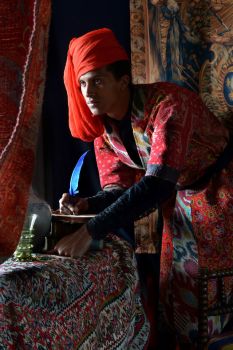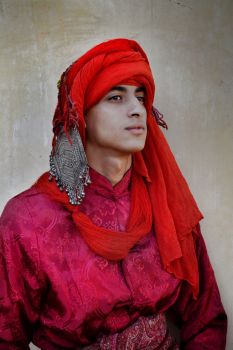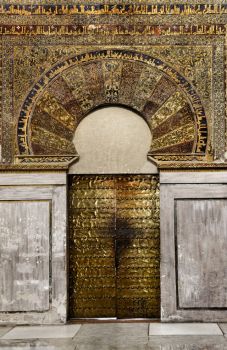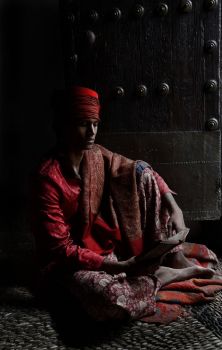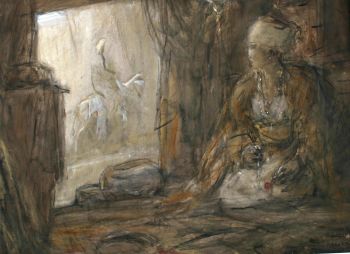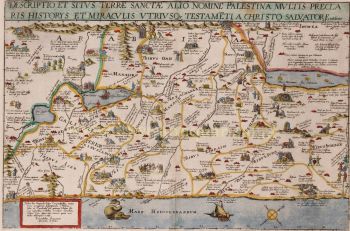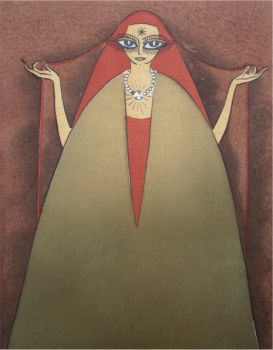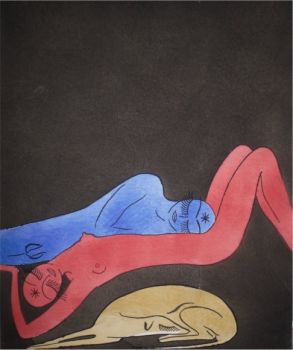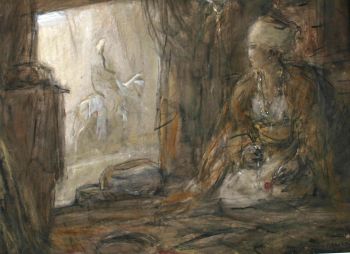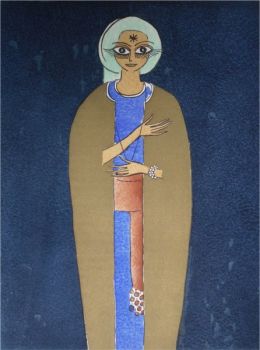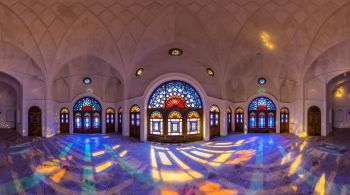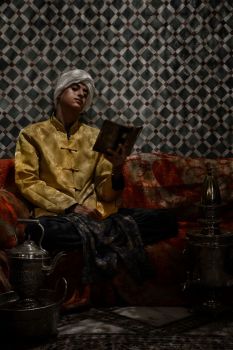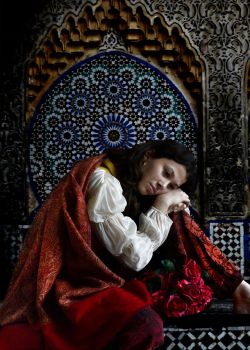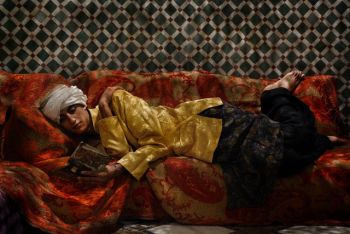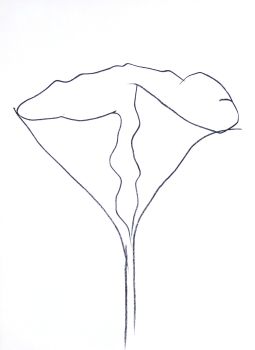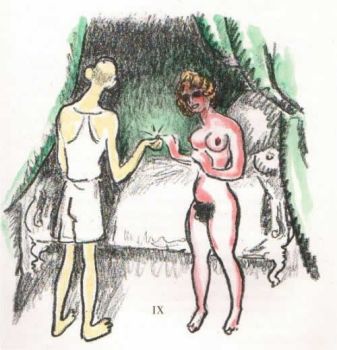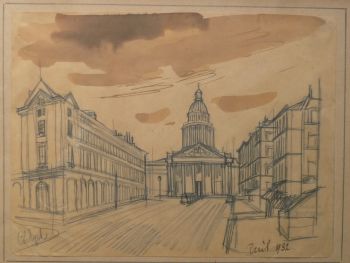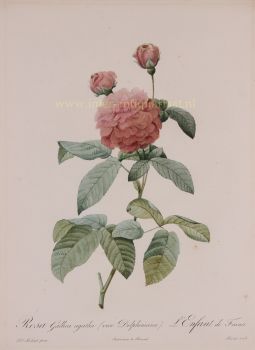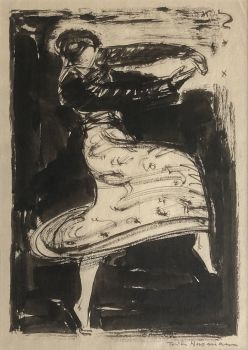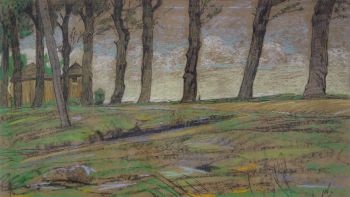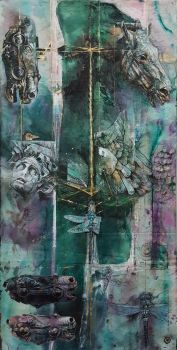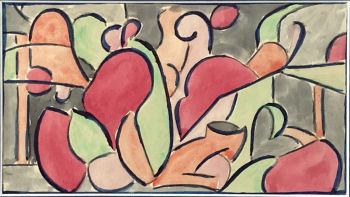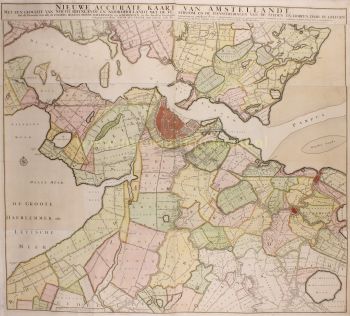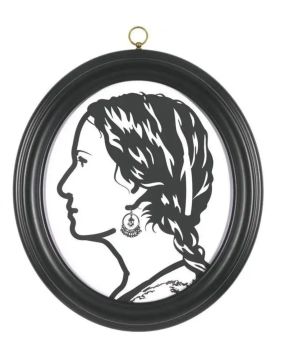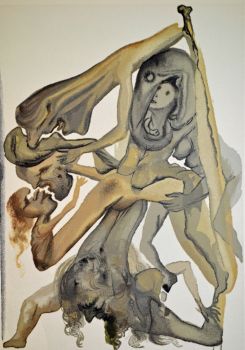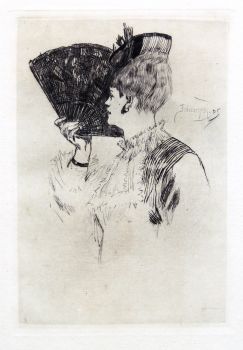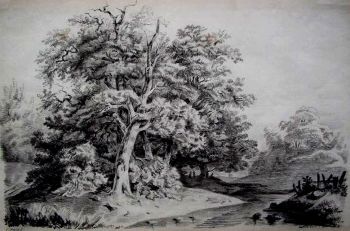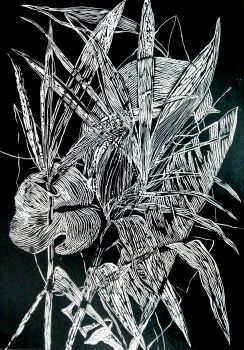Printed and bound at the first Arabic printing office in Lebanon 1776
Monastery of Saint John the Baptist at Dayr al-Shuwayr
CartaPelle
Attualmente non disponibile tramite Gallerease
- A proposito di opere d'arteKitab al-Injil al-sharif al-tahir wa-al-misbah al-munir al-zahir muqassaman kanayisiyan madar al-sanah hasaba tartib al-Anba al-Qiddisiyin al-Sharqiyin [= Book of the liturgical Gospels].
Dayr al-Shuwayr (or Dhour el Choueir, in Lebanon), Dayr Mar Yuhanna [= Monastery of Saint John the Baptist], [1776]. Folio (31.5 x 22.5 cm). A Greek Melkite Evangeliary in Arabic, with each page in a border of thick-thin rules, pp. 245-300 printed in red and black, and a woodcut Madonna and child. The title-page has been sophisticated, probably in the 18th-century, and appears to be a badly inked proof that has been touched up in manuscript. Bound by the Dayr al-Shuwayr Monastery in contemporary gold- and blind-tooled reddish-brown goatskin morocco, each board with a gold centrepiece.
Very rare second Arabic edition (the first to be printed in Lebanon) of the four Gospels arranged for liturgical use in the Greek Melkite Church, to make readings for services according to the day of the year: a so-called Evangeliary or Evangelion. It was intended primarily for Arabic-speaking Christians in the Middle East, rather than for missionary work. The first Arabic edition was printed and published at Aleppo in 1706. Al-Shamas Abdallah Zakher (1684-1748), son of an Aleppo goldsmith, worked at the Aleppo printing office but had to flee in 1722 because of disputes that were to lead to the 1724 schism in the Melkite Church. Zakher established the printing office of the Melkite monastery of St. John the Baptist at Dayr al-Shuwayr in the Lebanese Kisrawan mountains, where he produced a psalter in 1734. He is said to have been skilled in jewelry-making and cutting in metal and wood, and to have cut the punches for the 1734 Arabic type. The printing office produced about 70 Arabic editions before it closed in 1899.
With marginal manuscript notes in Arabic script, the stamp of a Diyarbakir (in Anatolia, eastern Turkey) library in the margin of the last page. With the title-page sophisticated as noted, some mostly marginal water stains, an occasional small stain, a tiny and unobtrusive worm hole in the second half, but mostly in good condition and with large margins. The binding rubbed and slightly chipped, with the front hinge and fore-edge corners restored and the inside front hinge reinforced. Very rare early example of an Arabic liturgical work, printed and bound at the Monastery of St John the Baptist in Dayr al-Shuwayr, Lebanon.
Darlow & Moule 1661; KVK & WorldCat (3 copies); Schnurrer 360; for Zakher: J.E. Kahale, Abdallah Zakher (2000); Hanebutt-Benz et al., Middle Eastern languages and the print revolution (2002), pp. 179-181. - A proposito di opere artistaL'Ordine Basiliano Chouerita di San Giovanni Battista è un ordine religioso della Chiesa greco-cattolica melchita. Il nome latino di questo ordine è Ordo Basilianus Sancti Iohannis Baptistae, il nome francese è Ordre Basilien Chouerite de Saint Jean Baptiste, l'abbreviazione usata dopo il nome è a.C. Questo ordine fu fondato nel 1696 da cinque monaci (tra cui Neophytos Nasri) che lasciarono il Monastero di Balamand per cercare un luogo tranquillo dove seguire meglio la regola di San Basilio. Si stabilirono nel 1710 nel villaggio di Choueir (o Dhour El Shuwayr, vicino a Khinchara) nel Monte Libano utilizzando la chiesetta di San Giovanni Battista, da cui presero il nome e che è tuttora la loro casa madre. Nel 1733 Abdallah Zakher fondò una Macchina da stampa in lingua araba a caratteri mobili nel monastero di San Giovanni a Choueir, la prima macchina da stampa artigianale in Libano.[4] Nel 1757 papa Benedetto XIV approvò le loro regole particolari, e l'approvazione definitiva da Roma fu data nel 1772. L'Ordine Basiliano Salvatoriano divenne ben presto uno dei due principali ordini religiosi della Chiesa Cattolica Melchita. L'altro ordine era l'Ordine Basiliano Salvatoriano. Secondo la loro tradizione, l'Ordine Basiliano Salvatoriano aveva uno scopo più missionario, mentre l'Ordine Basiliano Chouerita era più contemplativo. L'Ordine Basiliano Salvatoriano reclutava nelle aree di Damasco e del Libano meridionale, mentre l'Ordine Basiliano Chouerita reclutava nelle aree di Aleppo, Homs, Libano settentrionale e Galilea. I tentativi di unire questi due ordini nel XVIII secolo sono falliti: l'opposizione tra loro e tra le diverse comunità da cui reclutano membri è un aspetto importante da comprendere nella prima storia della Chiesa cattolica melchita. Tra il 1824 e il 1832 l'ordine si divise in due rami: l'Ordine Basiliano Alepico (formato principalmente da monaci provenienti dalla zona di Aleppo), e l'Ordine Baladita o Basiliano Chouerita (proveniente principalmente dal Libano e dalla Galilea). L'ordine ha fondato il suo seminario nel 1880 e gestisce molte parrocchie in Medio Oriente. Tre patriarchi melchiti e circa 36 vescovi erano membri dei Choueriti basiliani. La prima edizione araba fu stampata e pubblicata ad Aleppo nel 1706. Al-Shamas Abdallah Zakher (1684-1748), figlio di un orafo di Aleppo, lavorò presso la tipografia di Aleppo ma dovette fuggire nel 1722 a causa di dispute che avrebbero portato a lo scisma del 1724 nella Chiesa melchita. Zakher stabilì la tipografia del monastero melchita di San Giovanni Battista a Dayr al-Shuwayr nelle montagne libanesi di Kisrawan, dove produsse un salterio nel 1734. Si dice che fosse abile nella creazione di gioielli e nel taglio di metalli e legno, e di aver tagliato i punzoni per il tipo arabo del 1734. La tipografia ha prodotto circa 70 edizioni arabe prima della sua chiusura nel 1899.
Artwork details
Related artworks
Antonie Derkinderen
Memory book Exhibition of Dutch Painting1892
Prezzo su richiestaKunsthandel Pygmalion
Tilmanus Nicolaus Maastricht
Missale Romanum con fornimenti d'argento olandesi1788 - 1792
Prezzo su richiestaJacob J. Roosjen SRI
Engelbert Kaempfer
IL LIBRO DI ENGELBERT KAEMPFER1651 - 1716
Prezzo su richiestaZebregs & Röell - Fine Art - Antiques
Engelbert Kaempfer
IL LIBRO DI ENGELBERT KAEMPFER1651 - 1716
Prezzo su richiestaZebregs & Röell - Fine Art - Antiques
Yoko Ono
YOKO ONO: "ARISING" SIGNED BOOK PLUS SMALL ARTWORK 2010 - 2014
Prezzo su richiestaGallerease Selected
LAWRENCE WEINER
"SKIMMING THE WATER [MENAGE A QUATRE]" Signed book plus small artwork2010 - 2014
Prezzo su richiestaGallerease Selected
Antonie Derkinderen
Memory book Exhibition of Dutch Painting1892
Prezzo su richiestaKunsthandel Pygmalion
1 - 4 / 22Elisabeth Treskow
Lapislazzuli afgano intarsiato con oro su un supporto d'argento1950 - 1960
Prezzo su richiestaJacob J. Roosjen SRI
Artista Sconosciuto
IMPORTANTE E RARO GRANDE DIPINTO INDIANO "COMPANY STYLE" SU AVORIO RAFFIGURANTE UNA SFILATA1850 - 1900
Prezzo su richiestaZebregs & Röell - Fine Art - Antiques
 A cura di
A cura diDanny Bree
1 - 4 / 24- 1 - 4 / 24

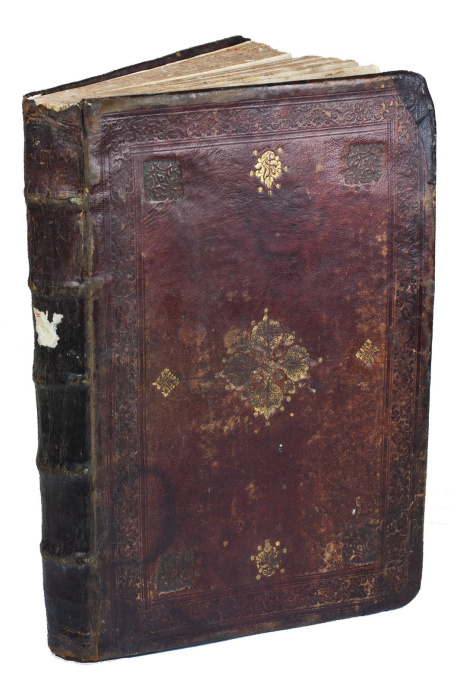













!["SKIMMING THE WATER [MENAGE A QUATRE]" Signed book plus small artwork by LAWRENCE WEINER](https://media-2.gallerease.com/images/442bfd5f-fc31-4e18-a2fa-ee0c08eade64/350x350/skimming-the-water-menage-a-quatre-signed-book-plus-small-artwork.jpg)




